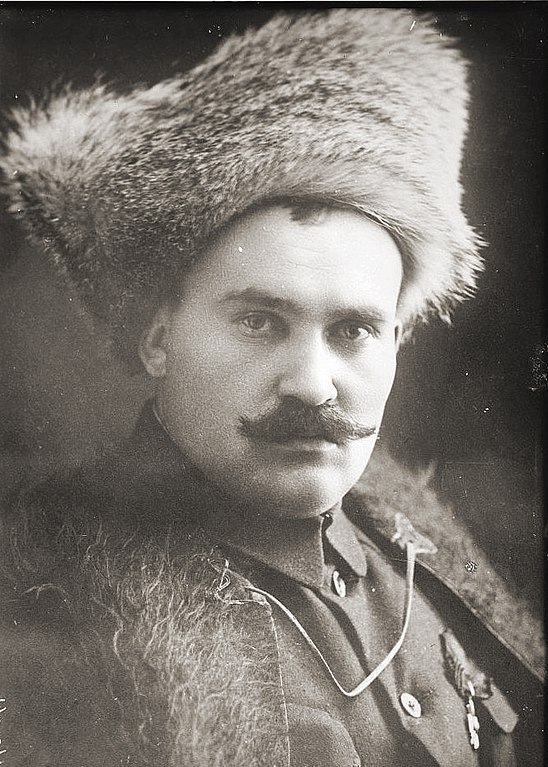Grigory Mikhailovich Semyonov was born on September 13, 1890 in a Cossack family. Educated at the village school, and also engaged in self-education. Semyonov was fond of archeology and paleontology, donated the materials of his research to the Chita Museum. From 1908 to 1911 he studied at the Orenburg Cossack School. He entered the rank of cornet in the Trans-Baikal Cossack troops Fr. Participated in the First World War , served in the 1st Nerchinsk regiment of the Ussuri division. In June 1917, Semyonov was appointed commissar of the Provisional Government in the Trans-Baikal Region for the formation of volunteer units. After the Bolsheviks came to power, in November 1917, Semenov openly spoke out against Soviet power.¹
On November 18, 1917, in Verkhneudinsk , Semyonov made an unsuccessful attempt to seize power. Then Semenov moved to Manchuria, where, with the support of General Horvath, he organized the “Special Manchurian Detachment”. He was elected ataman. In the first half of 1918, the chieftain fought the Bolsheviks in Dauria. In May 1918, he established the Provisional Trans-Baikal Government. In the summer of 1918, Semyonov occupied Chita. After he was appointed commander of the Separate East Siberian Army. In November 1918, a conflict occurred in Omsk with Admiral Kolchak, who did not recognize him as the Supreme Ruler of Russia. Grigory Semenov in the summer of 1919 was appointed field ataman of the Far Eastern Cossack troops and assistant commander-in-chief of the Amur military district with the powers of the military governor of the Transbaikal region. On December 24, 1919, the ataman was appointed commander-in-chief of the armed forces in the Far East, and already on January 4, 1920, Kolchak transferred his power to Semenov. In September 1920, the chieftain announced his subordination to the Government of the South of Russia as all-Russian. At the end of the year, Semyonov with his troops retreated to Primorye and continued the fight against the Bolsheviks. He made a number of trips to the USA, Canada and Japan to seek support for his units. In September 1921, the ataman left for Manchuria. In exile, together with Horvath and Diterichs , he became one of the brightest leaders of the white movement in the Far East. He worked closely with the Japanese military, did not recognize the influence of the ROVS .² He was acquainted with Konstantin Rodzaevsky. In 1938, in Harbin, he published his memoirs About Myself: Memoirs, Thoughts and Conclusions.³ In September 1945, Ataman Semyonov was captured by Soviet troops in Manchuria. By the verdict of the Supreme Court of the USSR, he was executed on August 30, 1946.⁴
On November 18, 1917, in Verkhneudinsk , Semyonov made an unsuccessful attempt to seize power. Then Semenov moved to Manchuria, where, with the support of General Horvath, he organized the “Special Manchurian Detachment”. He was elected ataman. In the first half of 1918, the chieftain fought the Bolsheviks in Dauria. In May 1918, he established the Provisional Trans-Baikal Government. In the summer of 1918, Semyonov occupied Chita. After he was appointed commander of the Separate East Siberian Army. In November 1918, a conflict occurred in Omsk with Admiral Kolchak, who did not recognize him as the Supreme Ruler of Russia. Grigory Semenov in the summer of 1919 was appointed field ataman of the Far Eastern Cossack troops and assistant commander-in-chief of the Amur military district with the powers of the military governor of the Transbaikal region. On December 24, 1919, the ataman was appointed commander-in-chief of the armed forces in the Far East, and already on January 4, 1920, Kolchak transferred his power to Semenov. In September 1920, the chieftain announced his subordination to the Government of the South of Russia as all-Russian. At the end of the year, Semyonov with his troops retreated to Primorye and continued the fight against the Bolsheviks. He made a number of trips to the USA, Canada and Japan to seek support for his units. In September 1921, the ataman left for Manchuria. In exile, together with Horvath and Diterichs , he became one of the brightest leaders of the white movement in the Far East. He worked closely with the Japanese military, did not recognize the influence of the ROVS .² He was acquainted with Konstantin Rodzaevsky. In 1938, in Harbin, he published his memoirs About Myself: Memoirs, Thoughts and Conclusions.³ In September 1945, Ataman Semyonov was captured by Soviet troops in Manchuria. By the verdict of the Supreme Court of the USSR, he was executed on August 30, 1946.⁴
Grigorii Mikhailovich Semionov (1890-1946)


Content Oriented Web
Make great presentations, longreads, and landing pages, as well as photo stories, blogs, lookbooks, and all other kinds of content oriented projects.
[1] Kuras, Leonid. “Ataman Semenov: Lyubov’, Pererosshaia v Predatel’stvo.” Vlast’, no. 2, 2014, pp. 184–88.
[2] Mertsalov, Viktor. “Politicheskoe ‘Litso’ Atamana Semenova (k Istorii Grazhdanskoi Voiny Na Dal’nem Vostoke).” Rossiisko-Kitaiskie Issledovania, vol. 2, no. 3–4, 2018, pp. 157–68.
[3] Semonov, Grigorii. O Sebe: Vospominania, Mysli i Vyvody. 2002.
[4] “Semenov Grigorii Mikhailovich.” Muzeevedenie, Regional’naia Istoria i Krayevedenie v Sovremennykh Issledovaniakh i Praktikakh / Pod Redaktsiyey P.P. Vibe., 2015, pp. 422–24.
[2] Mertsalov, Viktor. “Politicheskoe ‘Litso’ Atamana Semenova (k Istorii Grazhdanskoi Voiny Na Dal’nem Vostoke).” Rossiisko-Kitaiskie Issledovania, vol. 2, no. 3–4, 2018, pp. 157–68.
[3] Semonov, Grigorii. O Sebe: Vospominania, Mysli i Vyvody. 2002.
[4] “Semenov Grigorii Mikhailovich.” Muzeevedenie, Regional’naia Istoria i Krayevedenie v Sovremennykh Issledovaniakh i Praktikakh / Pod Redaktsiyey P.P. Vibe., 2015, pp. 422–24.